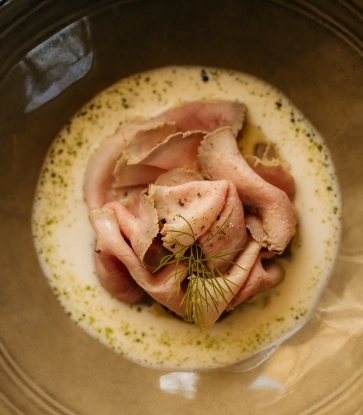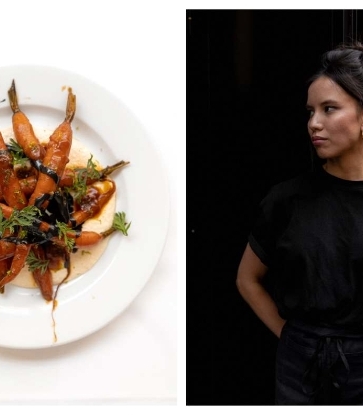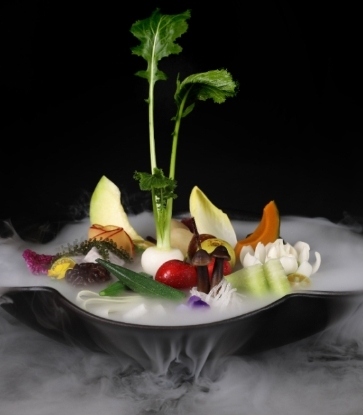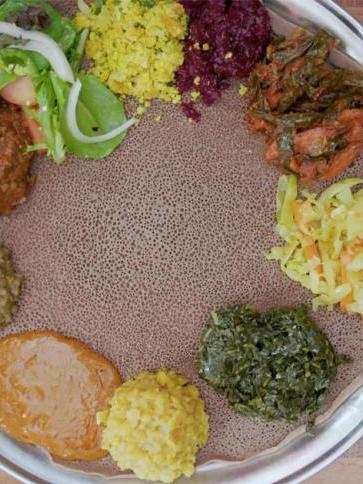Regional Chef Lai Chung Man is a vegetarian himself, having worked in vegetarian restaurants of every kind. And he knows the ins and outs of every greens.
“Seasonality is a major attribute of Shanghainese cuisine. For instance, spinach is at its best in April because it contains the highest amount of iron then. That’s when we highlight spinach on our menu. We also strive for authenticity. Lots of the ingredients we use come from Shanghai,” Lai said.

The Shanghai imports at Kung Tak Lam include Indian aster – locally known as ma lan tou – sourced from Shanghainese grocery shop Old San Yang, as well as the smooth and springy noodles used in the restaurant’s signature cold noodles. They are steamed for 15 minutes, scalded in hot water between 120°C to 140°C, and finally rinsed under cold water to accompany a platter of side ingredients like peanuts, swede and green bell pepper. It’s up to the diners to add their favourites on top. The dish is as interactive as it’s delicious.
A rich flavour with the right amount of salt is the highest ideal for Shanghainese vegetarian food. To achieve this, soy sauce is Lai’s trusted ally in kitchen. For instance, he specifically adjusts the flavour of the soy sauce to cook the wheat gluten on the starter platter. No wonder it turns out perfectly seasoned.
The Master Touch
With fresh produce on hand, it all depends on the chefs to work their magic.
“Technique goes a long way in making vegetarian food. It takes exceptional knifework to carve humble-looking vegetables into vivid characters for plating. It’s even more demanding in the sophisticated dishes such as Wensi tofu soup. With a tofu divided into two pieces, one needs to make 60 to 70 cuts on each half without breaking, so that it blooms beautifully like a flower in the soup,” Lai said.


Breaking the Boundaries
Since the arrival of Lai, the lineup of dishes at Kung Tak Lam has been transformed with a blend of tradition and creativity. He is hopeful that his new items would appeal to the younger crowd and non-vegetarians, and consequently, healthy vegetarian diet will be more appreciated.
“I understand that many people avoid vegetarian dishes because they find meat irresistible. That’s why I like to have mushrooms in my dishes. In a way, their flavour is stronger, closer to that of meat. In the case of double-boiled soup, the traditional version tastes quite light with only herbal ingredients. But with the addition of mushrooms, chestnuts and carrots, it becomes richer like meat-based soups, which makes it easier for non-vegetarians to accept,” Lai explained.

“Everything needs to be photogenic in this era. Vegetarian cuisine was never judged by its look, but with social expectations changing, I’ve started making mushroom bun and swan pastry,” Lai said.
While the bun filled with mixed mushrooms is no different from its traditional counterpart, its visual resemblance to real shiitake mushroom is striking. Swan pastry incorporates seasonal greens like mushroom, Chinese celery and carrot. Its gilded crust and adorable shape should garner hype on social media.
The attractive dim sum collection earned Kung Tak Lam much attention about half a year ago. Carrot pastry was a major talking point, as the fluffy, deep-fried vessel containing diced carrot, shiitake and chanterelle mushrooms was a vivid lookalike to the root vegetable. The lovable pumpkin bun surprised diners with the filling of mashed azuki beans and pine nuts. With that, Lai has brought Shanghainese vegetarian cuisine to the new age, and led Kung Tak Lam to another level.


















